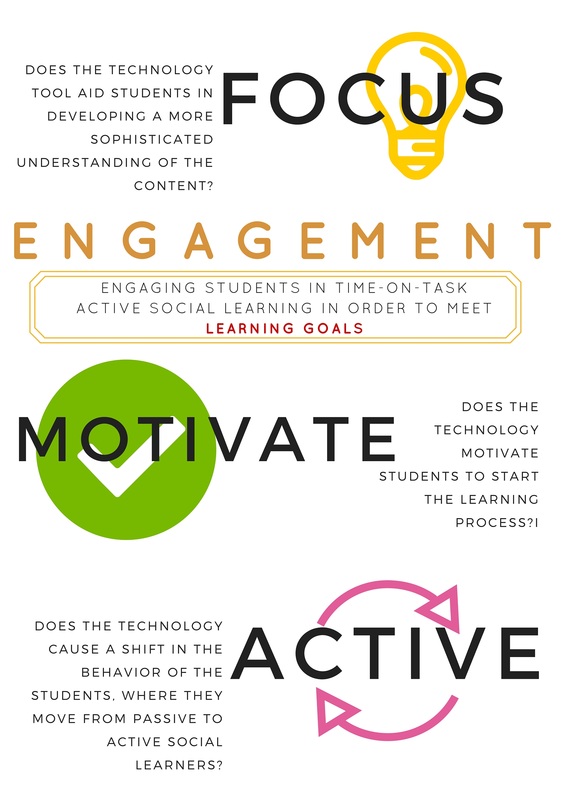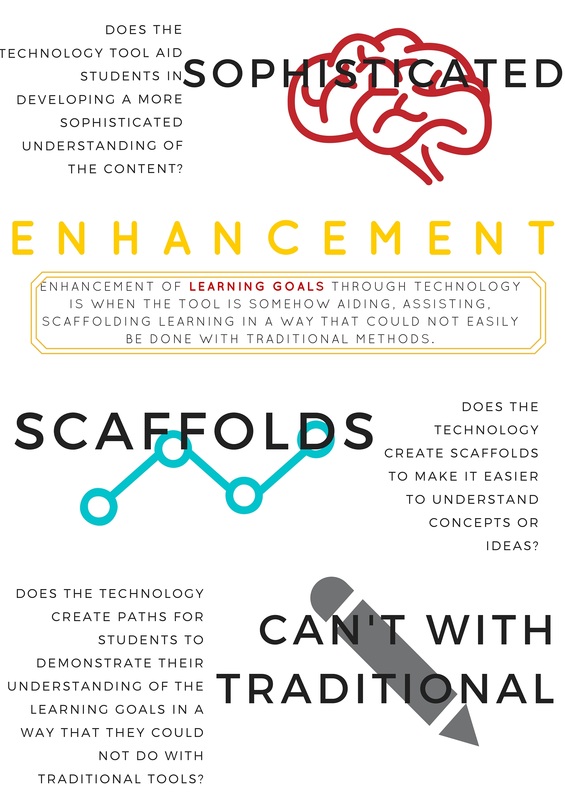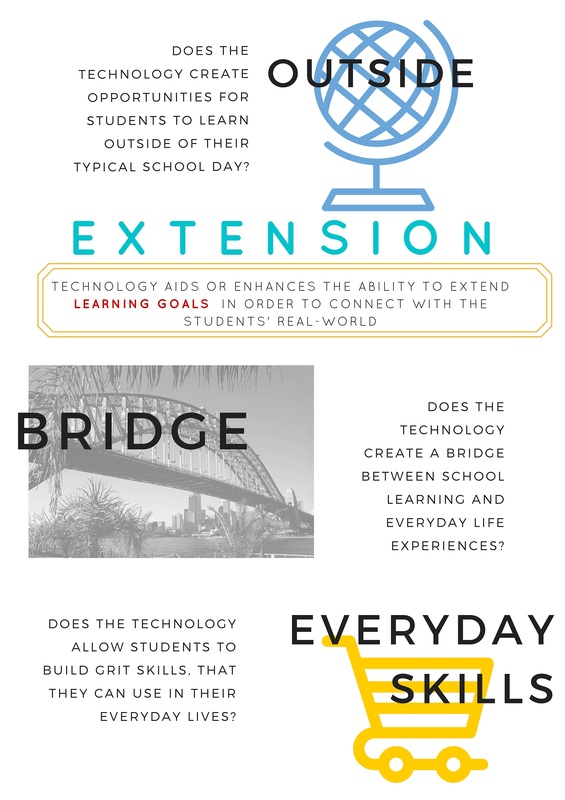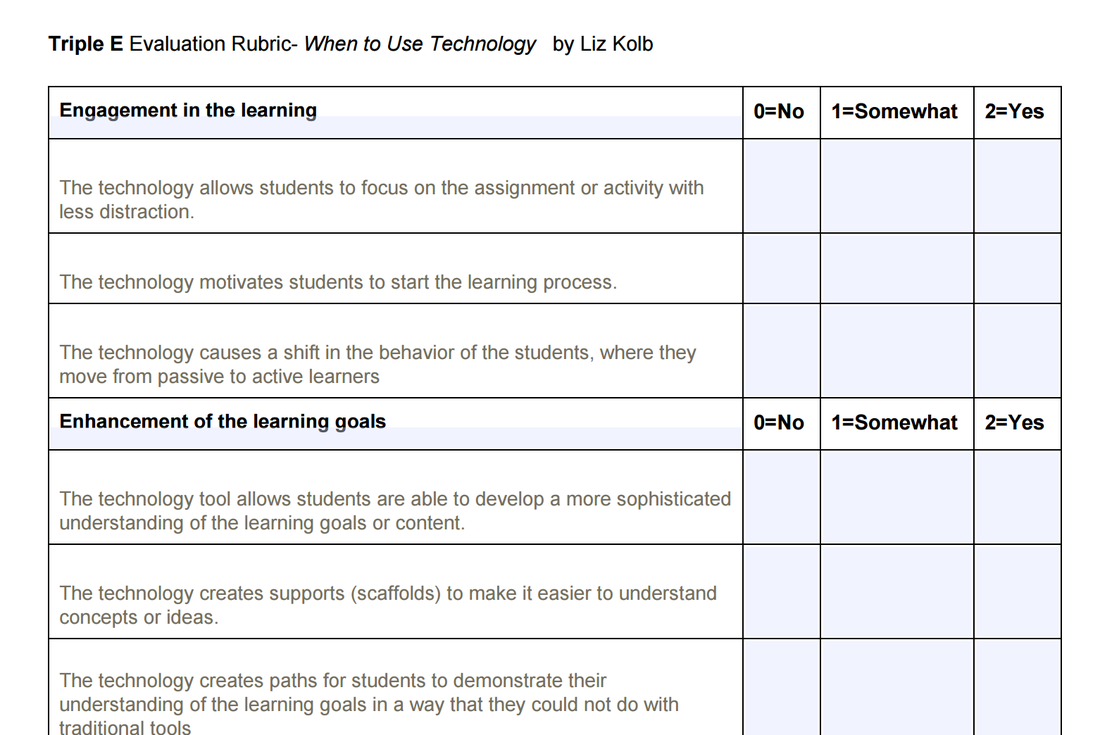EDU 807 Spring 2018 - Week 2 - Triple E Framework Group 2
Triple E Framework
About the Triple E Framework
Created by Dr. Liz Kolb, University of Michigan
http://www.tripleeframework.com/
|
What is the Triple E? The Triple E Framework attempts to define what it should look like, sound like and feel like to integrate technology tools into teaching in order to meet and exceed learning goals. The framework is based on three levels, Engagement in learning goals, Enhancementof learning goals, and Extension of learning goals. While these terms are often used interchangeably, they are distinct and different. The Triple E Framework defines each term and show examples of what makes each one unique and measurable.
The Triple E Framework is based on a considerable amount of research about what works and does not work when it comes to technology in learning. In particular it emphasizes...
Read more about the research and links here
The Triple E Framework was developed in 2011 by Professor Liz Kolb at the University of Michigan, School of Education. The Triple E was created to fill a gap that has been pervasive in educational technologies---How to effectively integrate technology tools in K-12 learning so they have a positive impact on student achievement and learning outcomes.
WHY Triple E? The research on technology and learning over the past decade is fairly clear, technology should be integrated based on what we already know about good teaching and pedagogical practices. Dating back to the late 19th century, the foundation of current teaching practices is based on the work of pragmatism. Pragmatists like John Dewey (1897) pushed for learning to be embedded in the student's authentic everyday lives, socially constructed knowledge, active/hands-on learning and full of choice. Since the early 1990s Research has found that educational technology with a "drill and practice" approach often has no effects on learning or cognition. Yet, most technology tools created for education are still drill and practice and in the lower-order of Blooms Taxonomy.
Despite media often claiming a new piece of technology as a way to "revolutionize" learning, that is almost never the case. The Triple E framework takes this fallacy of technology as the magic bullet learning into account, and allows teachers to become critical consumers of making mindful choices around technology tools in their teaching. It is a simple framework, based on research, that helps educators create lessons that allow students to use technology to meet and add value to learning goals as active, social, creative learners, in authentic ways.
How Triple E is Different than other Tech Integration Models
Triple E Level 1: Engaged Learning
|










0 General Document comments
0 Sentence and Paragraph comments
0 Image and Video comments
Going back to a little of what I posted in last weeks articles, why does this framework have to be about tech. You can easily remove every reference to technology, replace it with media, and it will work for all education. I dont feel this is a technology framework. It is a good education framework that good teachers do with all the ways that they introduce material to their students. To make technology successful, just use the same teaching techniques that have been associated with those great teachers and apply it to the technology you want to use. Some technologies make it easier to accomplish certain tasks and provide new possibilities to use. But the “framework” and basics of good quality teaching are the same no matter the media IMO.
New Conversation
Hide Full Comment
I think this framework assumes that teachers aren’t going to apply the same techniques that have worked successfully in their class to the technology they are going to utilize. Relating to real world experiences isn’t a technology idea, but a teaching idea that has been around for decades.
New Conversation
Hide Full Comment
I think this sentence is key and explains how EEE is different to other frameworks that do not focus on learning goals.
There is a big assumption however that teachers already know how to use tech in their classrooms in order to be able to encourage EEE. New teachers still need a framework (in my opinion) to follow to help them to understand how to integrate tech in a meaningful way.
I also like the PURIA model
https://www.uwlax.edu/uploadedFiles/Academics/conted/TMT/2016-TMT-handout-Kratky.pdf
to build teachers’ confidence when trying out a new tool!
New Conversation
Hide Full Comment
This sentence is key when we think about how to integrate technology. The use of tech should be aligned to good teaching and good pedagogy and also encourage EEE! I love this model Extend Enhance and Engage as this encourages tech to be used at a level that promotes not only engagement, but higher order thinking and learning extend beyond the classroom. This is the goal for using tech in the classroom.
New Conversation
Hide Full Comment
This framework assumes that students need help integrating technology into their education and will continue to have this need to reach high levels of achievement and learning outcomes. It also assumes that students need tools to learn things. In my opinion, 2+2 is the same thing whether it is done with pen and paper or a calculator or excel… the same point gets across and I wonder if integrating technology for basic concepts can end up being detrimental.
I also believe, like all learning theories/technologies/standards, this idea assumes all students learn the same. The questions of, does the technology motivate/engage/change behavior of students may fit half a class but not all or maybe students in NY react differently than students in CA.
New Conversation
Hide Full Comment
I think this assumes that all students like technology. I taught low level students in low-socioeconomic areas in High School for 10 years. Many of my students didnt have access to any of the technology that we were using in class at times (computers, internet, youtube, gaming) and rather than being interested, they were intimidated or frustrated. This would often cause them to shut down which is a common response for struggling students. Technology often made it very difficult to reach these students and get them involved without one-on-one guidance from the teacher which isnt really possible in most instances.
New Conversation
Hide Full Comment
This kind of relates to both students and teacher assumptions, but, I would think it would take time to understand from a teachers prospective if a students is engaging and not just “busy”. I would think that it would take months to understand all students in a classroom and know if the technology is working.
New Conversation
Hide Full Comment Hide Thread Detail
I agree with you Sarah. How do we measure engagement levels and distinguish the difference between this and being “busy”. I think you are right in that we need to study the affect of the technology over months to see the true impact.
New Conversation
Hide Full Comment
Is this true? Perhaps in high school and college it would be applicable but does this apply to elementary and middle school aged children, or preschool? Is a learning outcome as simple as a student understand why WW1 began or how they can apply world history to their interests? I like this Triple E framework but I could think that the learning outcomes and what educators want students to be able to achieve would need to be constructed before being able to measure these ideas related to technology
New Conversation
Hide Full Comment Hide Thread Detail
I agree with you again Sarah. I suppose it depends on the definition of authentic. I don’t want to mix up authentic and real life. Sometimes we learn math for the beauty and creativity so I would prefer to use te word learning in context!
New Conversation
Hide Full Comment Hide Thread Detail
I am not sure what they mean by Authentic, but the real world applicability is key for all ages. When young students can go home, and “help” their parents count money or tell them about how a seed grows into a tree, that real world usage for them helps make the material stick better and gets them interested in learning more. If you teach them math because they need to know it, it wont be nearly as engaging and exciting as if you give them a way they can go home and use it. I think that is one reason some math teachers lose students attention in those grades 2-6 because they push the practice sheets more than an idea of go home and figure this out about your house…. I still remember my 7th grade teacher giving us homework that involved answers from our own lives. She checked the progress, but there was no set numbers. We gathered the info, did the calculations, and solved a practical “problem”.
New Conversation
Hide Full Comment Hide Thread Detail
A little bit off topic but relating to what we are discussing with applicability, just came across this article:
https://www.nbcnews.com/think/opinion/digital-technology-must-empower-next-generation-workers-not-alienate-them-ncna838806
New Conversation
Hide Full Comment
General Document Comments 0


For this week, please look for a segment in each text where you can reply to the following:
What does this framework for using technology in education assume about teachers and teaching?
What does this framework for using technology in education assume about students and learning?
Please offer at least one comment related to the assumptions about teaching, as well as at least one comment on each document related to the assumptions about learning (2 initial comments). Then, please reply to at least two different classmates on one of their comments (2 responses).
New Conversation
Hide Full Comment